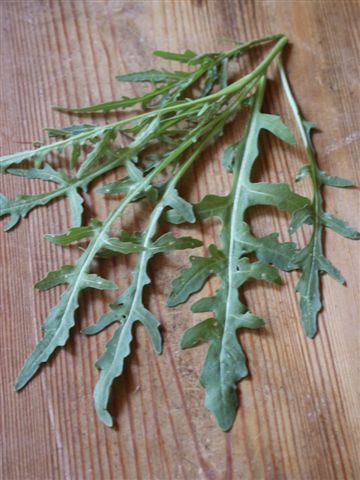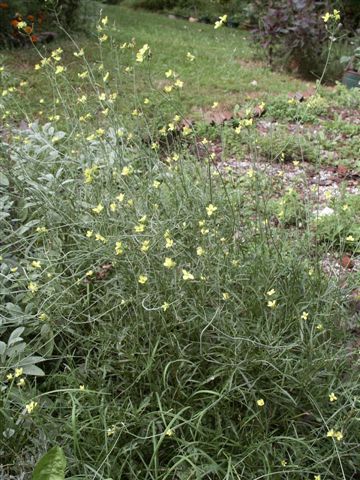
Eruca vesicaria subsp. sativa
Rocket, commonly known as Arugula
Native Habitat: Italy
Plant Type: Annual or perennial
Rocket (Eruca vesicaria subsp. sativa) is an ancient plant, cultivated or gathered from the wild in most Mediterranean countries; over the past decade it has become popular in North America. Its several names in Italian indicate how widespread it is on the peninsula: arugula, ruchetta, rucola; in French it is known as roquette.
Arugula or rocket’s very distinctive taste, which some find too pungent for their palate, is peppery, nutty and just slightly bitter; it is related to the mustards and nasturtium and can have that same kind of peppery bite to the tongue. Other descriptions I have heard and used to illustrate the flavor include mustard, peanuts, radish, horseradish, bacon, and smoky. These flavors mute when rocket is cooked, but it still has a richness and depth unlike any other green. The yellow or cream-colored purple-veined small flowers, which have the cross-shape that distinguishes mustard and other crucifers, make excellent garnishes.
How to Grow
Plant seeds of the annual Eruca vesicaria subsp. sativa outdoors in full sun to part shade (in really hot climates it lasts longer in shade and doesn’t get quite so pungent), 1/4-inch deep in well worked and moisture retentive soil, as soon as the soil can be worked in spring. Thin them gradually, harvesting them for salads, so that they are about 6 inches apart. Like many salad greens, arugula doesn’t like hot weather and will want to bolt. In my zone 7 garden, I sow seed in early spring, late spring to early summer, and late summer to early fall, about four weeks or so, to insure continuous harvest. It is a rapid grower. Or you can just let them behave like those perpetual patches, let them drop seed and return next year where they will.
I am delighted to report that I have a strain of wild rocket that returns every year. I am not sure from whence it came, or its name, however, it has been returning every year in my Maryland zone 7 garden for about seven years now. It gets quite huge when it flowers and the flowers are yellow rather than the usual creamy white with the purple cross. The leaves are much narrower than that of Eruca vesicaria subsp. sativa, which I have sown often from seed over the years. The flavor of this particular arugula is strong and can be quite hot. If any of you gardeners out there know the botanical name of this plant I sure would appreciate your writing to me!
Culinary Uses
Like any salad green, the leaves can be gritty, so wash them well first. I couldn’t live without my salad spinner; I use it practically every day. I pick my salad into the spinner bowl, take it inside and fill it with cold running water and a few tablespoons of vinegar. The vinegar makes the grit and any varmints you may have brought in with you drop to the bottom of the bowl. Then I pick over the leaves and tear them if desired as I transfer them to the spinner basket. I carry the bowlful of water out and water a thirsty plant with it. Then I give the contents another quick rinse under running water and finally spin them dry.
Use the greens, first and foremost, in salads of every description from your basic green salad to mixed greens; arugula is wonderful paired with tomatoes in any way, shape or form; I especially enjoy the contrast of the flavorful leaves with the velvet texture of a perfectly ripe avocado; and it combines well with just about any cheese. The leaves spice up grain or pasta salads, egg or potato salad. I love arugula tossed with hot pasta and heaped on pizza straight from the oven. It is one of my most-often used herbs for salsa verde and is good in soups and stir fries. Use the flowers to garnish any dish that you use the leaf in.
Arugula is a good source of vitamins A and C as well as iron. Medicinally, it is used as a tonic herb. Enjoy my recipe for Arugula and Balsamic Tomatoes as a salad or on bruschetta—it will liven up any picnic, cook-out, lunch or supper!
Fine Gardening Recommended Products

A.M. Leonard Deluxe Soil Knife & Leather Sheath Combo
Fine Gardening receives a commission for items purchased through links on this site, including Amazon Associates and other affiliate advertising programs.





















Comments
Log in or create an account to post a comment.
Sign up Log in